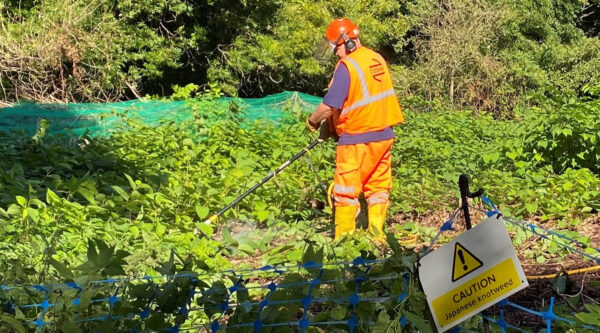Transport for London (TfL) has been carrying out a trial of a method of killing Japanese Knotweed infestations using electricity instead of chemicals.
Japanese knotweed is an invasive species introduced to the UK in the 19th-century and has been a problem ever since. It is extremely hardy, grows incredibly fast, damages buildings, oh and is very difficult to remove, so it’s now covered by legislation to try and control its spread. If you found any on your property, you would usually need to call in specialists to remove it, and it can even affect mortgage applications if found during a sale.
While the plants can cause damage by spreading within TfL property, if not dealt with and the plant spreads to a neighbouring site, then TfL could be held liable for the cost of removing it from there as well. So dealing with it is a serious issue. The common method of dealing with Japanese Knotweed is to inject chemicals like glyphosate into the plants, but it often takes several years of repeated applications to fully kill the plants right down to the roots.
The electric wands, developed by Warwickshire based Rootwave instead applies a high current charge to the plants as it is waved over them, and that causes the water in the plant to boil, damaging the plant’s cellular structure, above and below the ground, and it’s the damage done below ground that is critical in stopping the plant from regrowing.
Over the past 18 months, TfL has been testing the RootWave Pro to tackle Japanese Knotweed infestations, reportedly with high success at killing the troublesome plant. The way it works is that a mobile power generator unit is brought to the location, and then staff move through the site sweeping the area not unlike raking it, but with the electric wands that then kill the plants.
Craig Ward of TDS Vegetation at London Underground said that “The plant dies instantly when we use RootWave Pro, and crucially grow-back is significantly reduced compared to previous methods. On small sites we have seen one treatment remove the plant, but on the large, dense sites we have done it in two or three visits – halving the number of treatments we would expect to make with conventional methods.”
Where a large area of Japanese Knotweed would be treated by injecting glyphosate directly into the plants, Craig uses up to 12 men, but he needs a team of just two people to cover the same area with the electric wands. One of the other benefits of this trial is that where they use strong chemicals in the past, that also required specialist removal of the dead plants to a contaminated waste depot, here they are able to leave the plants to die on site and rot down naturally.
So a plant whose removal used to leave a blasted landscape in its wake is now able to be left to rot down as fertiliser for the next generation of more agreeable plants to take root.
Trials were carried out on three sites, and since then, TfL has bought two of the devices to carry out larger internal trials. One of those larger trials has been on a site near to the London Underground tracks in Harrow, West London.
The trials are still underway, but baring any totally unexpected problem, there could finally be a way of dealing with this pest of a plant.
Now, how about zapping the Buddleja?

https://www.ianvisits.co.uk/articles/tfl-testing-a-chemical-free-way-of-eliminating-japanese-knotweed-53274/





